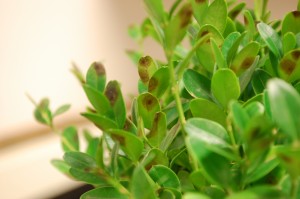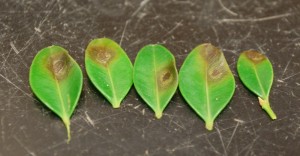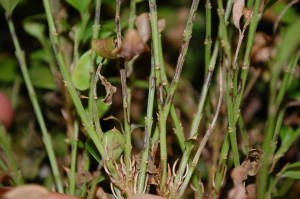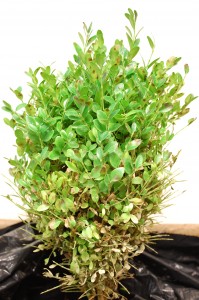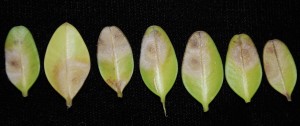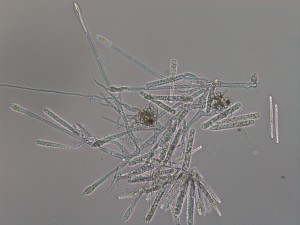Samples of boxwood infected with the fungus Cylindrocladium pseudonaviculatum, the cause of boxwood blight, have been confirmed by the Rutgers Plant Diagnostic Laboratory and the New Jersey Department of Agriculture Laboratory in recent days. This is the first report of the disease is New Jersey.
Boxwood blight has been a disease of serious concern in the United Kingdom since 1994. It was first reported in the United States in October 2011 in Connecticut and North Carolina. Since its initial detection, the problem has been reported in MA, MD, NY, OH, OR, PA, RI, and VA. New Jersey was late to the party and follows just behind reports of the disease in Delaware. Shipping plant material from state to state has moved the pathogen, so we were wondering what was taking so long! We expect to see more disease in the state as we move forward.
There are plenty of excellent resources available, so I won’t belabor the biology of the pathogen and its management here. What I want to do with this post is review the symptomology, and take time to remind everybody that in order to limit the spread of this disease, suspect samples should be officially confirmed and diseased plants carefully eradicated.
Initial symptoms of boxwood blight appear as light brown spots on the leaves. Spots enlarge, often with concentric circles or a zonate appearance, until entire leaves are blighted and shed. The fungus also infects woody tissues, which results in dark brown to black “diamond-shaped” lesions and stem dieback. Defoliation and stem dieback are rapid. Be aware that boxwood blight spreads very quickly in warm and humid conditions and has the potential to do significant damage to your plantings.
The causal fungus of boxwood blight, Cylindrocladium pseudonaviculatum, produces white sporodochia (fruiting bodies) on lower leaf surfaces and in stem lesions. They appear crystalline under a hand lens. Each sporodochium produces hundreds of conidia (asexual spores) that are easily spread by wind and water. Sterile apical vesicles (swellings), also produced in the sporodochia, aid us in the identification of the fungus.
If you suspect boxwood blight, carefully sample and double bag the plant material. If your suspects are new transplants or small in stature, whole plants are best. (Leave no leaf behind.) Please drive the samples to the lab for confirmation. I repeat, DOUBLE BAG YOUR SAMPLES! Please do not toss a plant in the bed of your truck and spew infected leaves down the turnpike on your way to the lab! We are very interested in tracking and limiting the spread of this insidious disease, so your cooperation is essential and greatly appreciated. How the majestic boxwood has fallen – the plant I love to hate!
